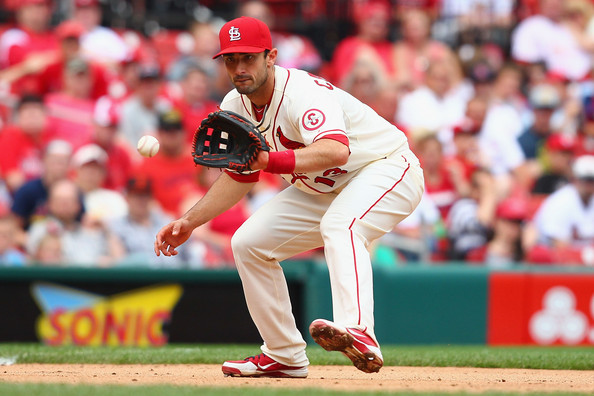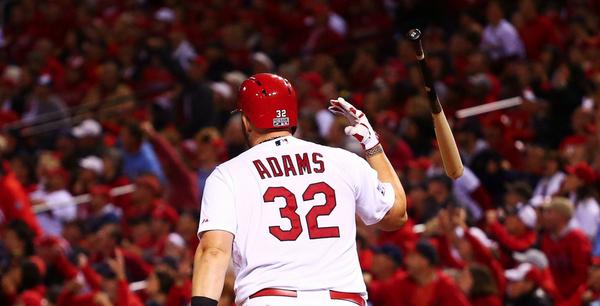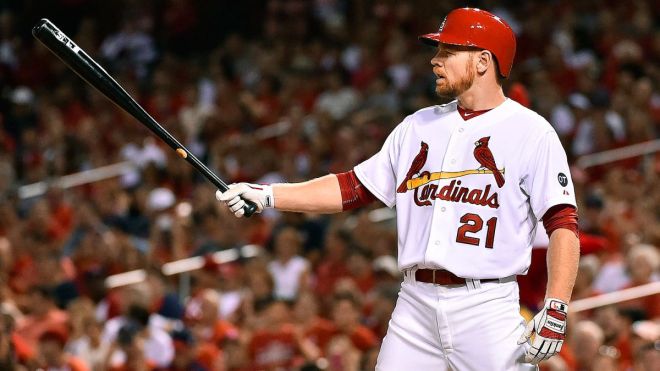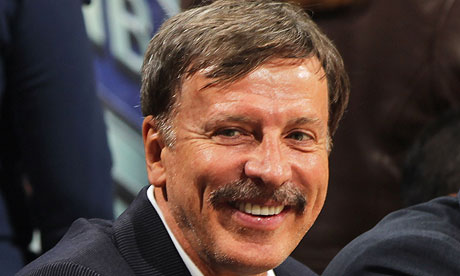Considering my busy schedule, I’ve been writing a lot lately; and there has been a lot to write about recently. The Rams ditched town, hockey is hockey-ing, and ZiPS released their annual projections, so there has certainly been quite a bit for me to discuss; and speaking of those projections, they will be cited, and we will be talking more baseball. So let’s do it.
On Monday, St. Louis columnist Bernie Miklasz wrote an article headlined, Cardinals Have Depth Among Position Players but is There a Star in the House? As a precursor, I have not actually read the article, but just the headline got me thinking and researching. So here’s my take on the proposed ‘issue’, apologies in advance to Bernie if I steal any of his points as it is unintentional.
Before we dive in I want to define what I mean by ‘star’ or ‘star-power’. A star is someone who is within the top 5 for MVP candidacy or Cy Young candidacy. A Paul Goldschmidt or Mike Trout or Kris Bryant type player that produces big numbers and can have an entire lineup or pitching staff revolve around him.
Moving on.
Last season, en route to becoming the first team since the 2011 Phillies to win 100 games, the Cardinals had no position player exceed the 6.5 WAR benchmark set by Jason Heyward and no pitcher exceed the 5.6 WAR benchmark set by John Lackey.
Both of those players are gone, which leaves the highest returning WAR being Matt Carpenter’s 3.9. 3.9 WAR certainly isn’t indicative of a bad player, but it’s definitely not star-level production. The highest ZiPS projected position players, in terms of WAR, for the 2016 Cardinals are Carpenter at 3.8 WAR and Yadier Molina at 3.3 WAR.
All solid numbers, but nothing to really revolve the world around. But, as I brought up earlier in my article about how underrated the Pirates were, ZiPS has a tendency to perennially underrate teams and players – looking at you, Royals.
If you’re looking for the stars in St. Louis, it takes a lot of optimism and hometown bias to find them. Fortunately for the sake of this article, I have both of those things in spades.
If you asked a random sample of 100 people that know the game of baseball, “who is the best position player on the St. Louis Cardinals?” your answers would vastly vary.
All of the stat-heads would tell you that Matt Carpenter is because of his combination of surprising power and his ability to get on base at a very healthy clip. Fans who watch the Cardinals on a day-to-day basis and trust their eyes more than the numbers – kind of like me – would tell you Yadier Molina is the best player on the Cardinals and it’s not up for debate. Optimists would tell you Randal Grichuk or Stephen Piscotty and pessimists would tell you Matt Holliday is still the best of a bad bunch.
Asking the same question to the same audience about who the best pitcher was would reveal many different answers as well. Stat-heads would say Carlos Martinez because of his ability to punch people out, keep the ball in the ballpark and do all of the things that FIP-people enjoy. The same people that told you Yadier Molina was the best position player would tell you that Adam Wainwright was clearly the best pitcher because of his ‘ace’ status and workhorse mentality and that won’t change until he retires. Optimists still believe in Michael Wacha and pessimists would argue for Lance Lynn – even though he’s hurt. But that’s all a different article for a different day.
Unlike a lot of other teams, the debate of who is the best position player and pitcher in St. Louis yields a multitude of different answers. It’s an extremely unique situation that the Cardinals have, as this exercise proves their exceptional depth but also proves their lack of top-end talent.
So are there any true “stars” in St. Louis?

If you’re really optimistic, you might believe that Matt Carpenter is the star in St. Louis. In 2013 he displayed his now legendary penchant for getting on base by posting a .392 OBP and leading the league with 126 runs scored, 199 hits, and 82 walks to only 98 strikeouts. 2 years later, in 2015, Carpenter demonstrated his surprising power, blasting 28 home runs, knocking in 84 runs, slugging a robust .505, still walking a healthy 81 times to augment a .365 OBP and doing all of this out of the leadoff spot.
In my years of studying baseball, I have broken down hitters into two categories; hitters either slug, or they get on base. If you do both, you’re a superstar, and if you do neither you’re not playing professional baseball.
Carpenter has shown the ability to both get on base and slug, but combining them is something we have yet to see. If he can, expect to see a season similar to his 6.3 WAR campaign in 2013, except look for more of those 55 doubles Carpenter mashed to leave the ballpark. Optimistically, Carpenter can absolutely be a superstar; realistically, he’ll continue to be a 4 or 5 win player that is vastly underappreciated and undervalued.
Much like Carpenter, it requires a lot of optimism to view guys like Randal Grichuk and Stephen Piscotty as superstars; but it is possible.
In just 350 PA in 2015, Grichuk produced a 3.5 WAR thanks to his terrific defense (9 defensive runs saved in just 783 innings in the field) and immense raw power (.548 slugging, .272 ISO). Projected out over 600 PA – again, according to my brilliant math skills – Grichuk produces 6.0 WAR and 29 HR; pushing superstar territory.

The only real issue with Grichuk is his strikeout rate is alarmingly high (31.4%) and his walk rate is far too low (6.4%) which produced a .329 OBP. Ideally, Grichuk cuts down his strikeout rate, walks more, and thus gets more pitches to hit, but it’s hard to complain about the numbers I just projected out. But for the sake of this article, not quite a superstar level player.
Stephen Piscotty is the position player wild card for St. Louis. A textbook case of ‘small sample size theater’, Piscotty posted terrific numbers in a small amount of PA – .853 OPS, .189 ISO, 143 WRC+ and a .372 BABIP thanks to the 13th highest average velocity on balls in play (approx. 305 MPH). As Fangraphs’ Mike Podhorzer pointed out, this could either be the tip of the iceberg for a budding superstar, or it could be a flash in a pan for a slightly above average outfielder.
So what do I make of all those numbers?
I think Grichuk has shown his peak. He’s an extremely athletic outfielder – Cardinals’ hitting coach John Mabry called him a “Lamborghini” this past spring training – who plays above average defense at all three outfield positions and can hit a baseball a long way. Of the two categories of hitters that I brought up earlier, Grichuk slugs, and he slugs well. But I think it’s rather unrealistic to expect him to get on base at the type of clip that would warrant the ‘superstar’ label his slugging prowess would justify.
As for Piscotty, I firmly believe that he is a lineup staple in St. Louis, and the crown jewel of the whole Albert Pujols episode (sorry, Michael Wacha). Throughout the minors he showed an ability to consistently get on base, and while in the majors he showed a much greater ability to drive the baseball – thanks to some swing adjustments he made during the 2014-15 offseason. Is he a superstar right now? Not yet, but his time is coming and I believe that.

The Cardinals may not have a Mike Trout-type perennial MVP candidate in their stockpile of position players, but unlike Mike Trout’s Anaheim team the Cardinals have next to no positional weaknesses and their depth is unmatched.
Catcher? The best defensive catcher in the history of the game and the backbone of the club resides back there. 3rd base? Carpenter and his projected 3.8 WAR. Jhonny Peralta and his 7.5 WAR over the past two seasons holds down the fort at SS, while Kolten Wong and Jedd Gyorko project out as a 3.5 WAR platoon at second. I evaluated 1st base just this past week, but between Brandon Moss and Matt Adams, St. Louis is still projected to post up 2.3 WAR. Between the outfield trio of Matt Holliday, Randal Grichuk, and Stephen Piscotty, the Cardinal outfield is projected to be worth 8.2 WAR in 2016. The Cardinals top 5 bench options – which I’ve designated as Matt Adams, Tommy Pham, Greg Garcia, Brayan Peña and Jedd Gyorko – are projected to be worth 6.3 WAR.
As I said, the Cardinals depth is unmatched, but they do lack star power. You can’t describe them as top heavy, but the midsection of the St. Louis roster is incredibly thick and talented.
Is it a 100 win team? Probably not, but is it the team that ZiPS has projected for 84 wins? To me, that seems like an insult. I brought this up the other day, but I believe St. Louis will thrive in the underdog role the media has placed them in.
And their stockpile of middle-end talent will be leading the charge.
Thanks for reading…
-Ryan







